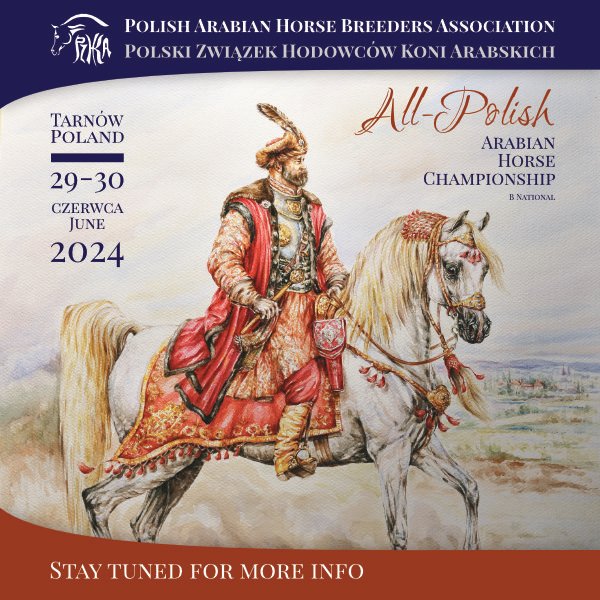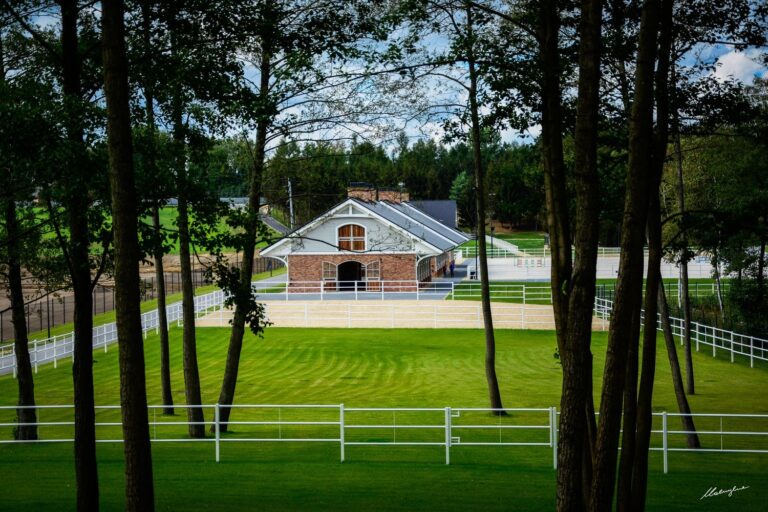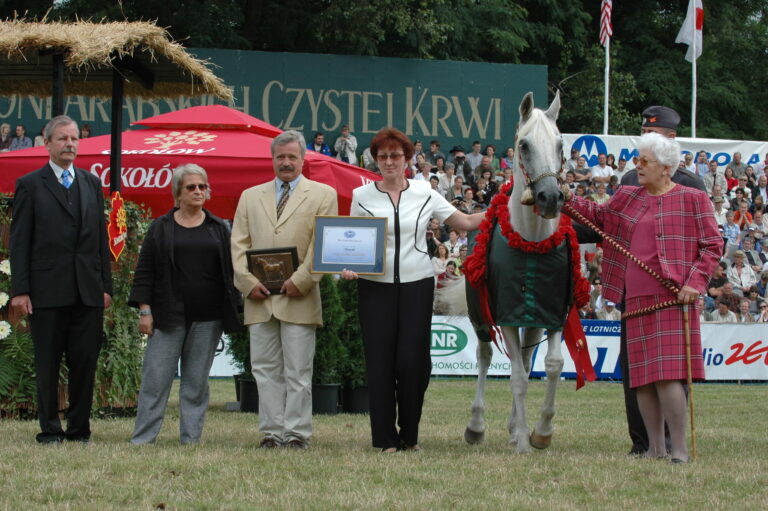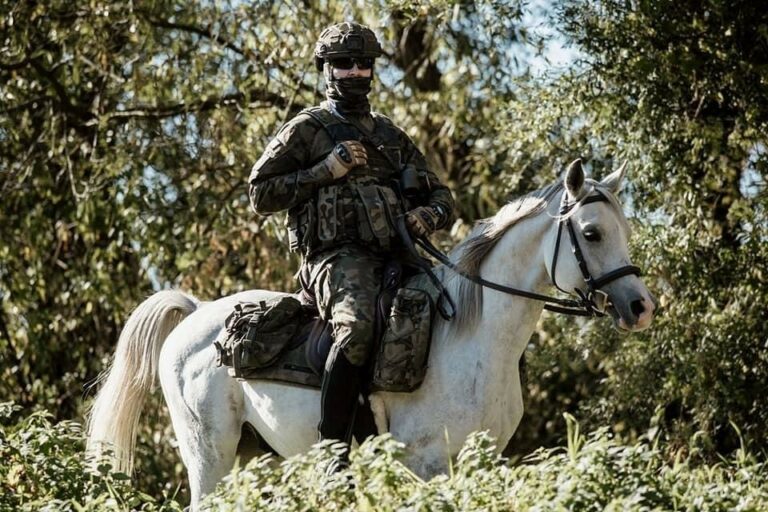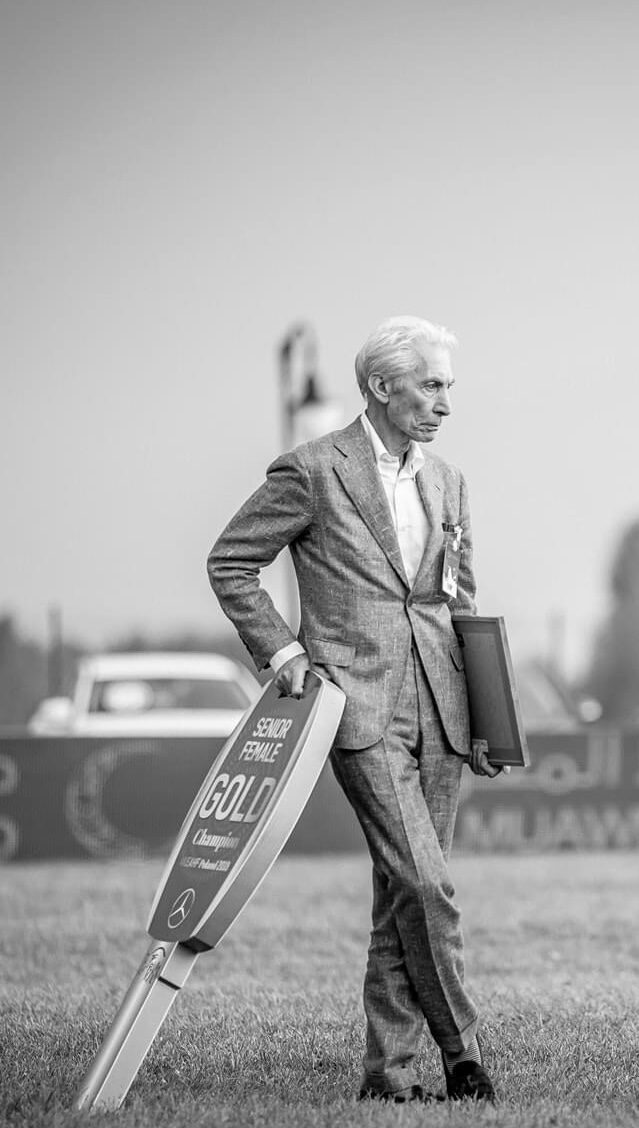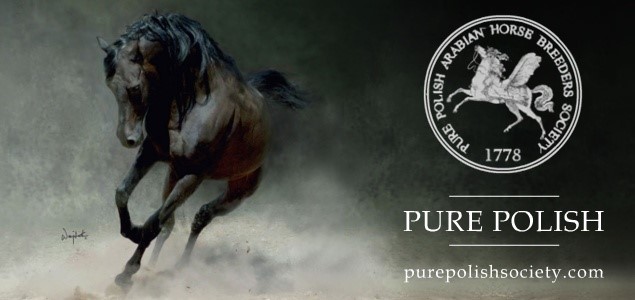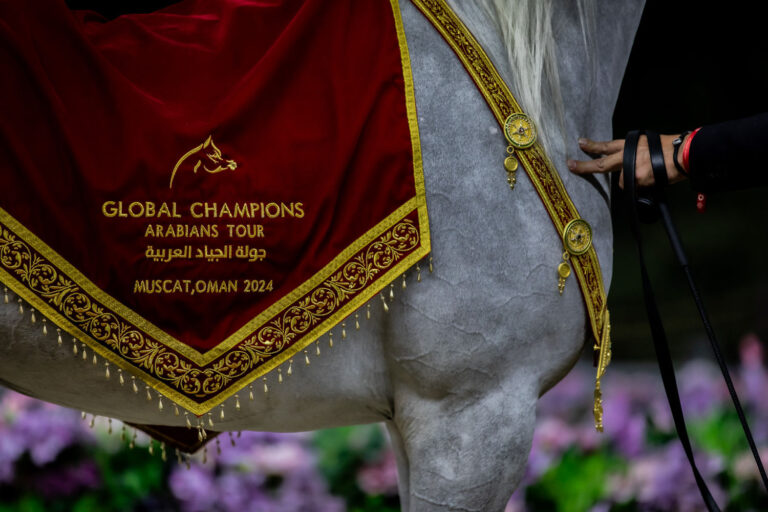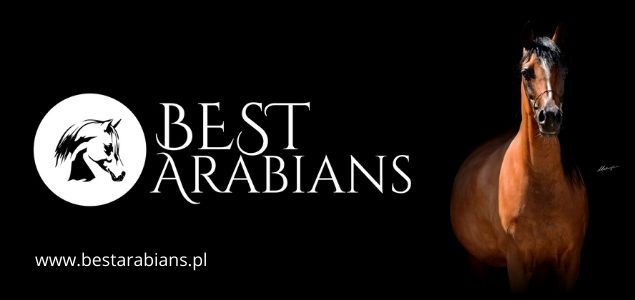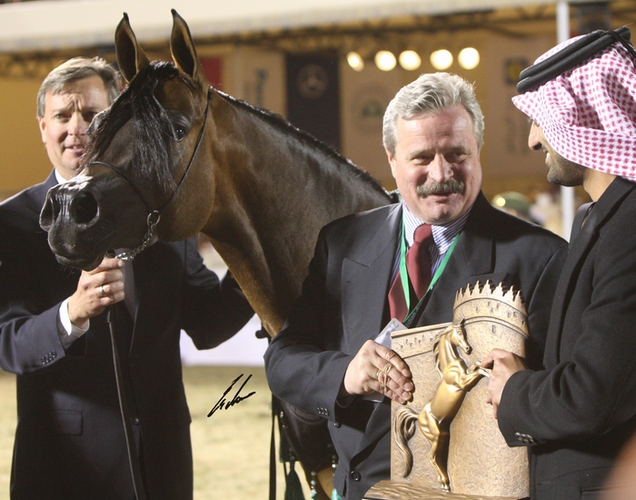
MAREK TRELA – the director of Janów Podlaski State Stud, which has over 190 years of tradition, one of the best known in the whole wide world. Breeder of Pianissima, who became a star of the show rings on various continents, the ambassador of the Polish breed who received twice the Triple Crown and her each step is followed by lovers of this breed in Poland and in the whole world. Mr. Trela arrived in Janów 31 years ago as a vet – today he is an acknowledged authority in Arabian horse breeding. He is also an international judge, the ECAHO treasurer and the host of the annual, prestigious auctions in Janów Podlaski.
Monika Luft: Do you feel like a star manager when every single information about Pianissima, like, for example, about her journey to the United States, raises excitement?
Marek Trela: I prefer not to… but I have a deep conviction that I am doing for this mare everything that would be the best for her.

M.L.: However, the commentaries are not always favorable… The French magazine “Le cahiers du cheval arabe” has written that Pianissima was exaggeratedly prepared in the American fashion, that she was afraid of her handler, that she is rather a marketing product than a ‘beloved’ horse and they even called her a ‘Barbie horse’. The commentary after Aachen was similar, emphasizing the fear of the handler.
M.T.: This kind of horse isn’t born every single day and it causes a lot of euphoria and frustration as well. I can’t be upset about it. The way that Pianissima looked on the shows gives a lie to the opinion that training in the United States takes the horse’s spirit away and destroys it psychically. In Paris, despite of many journeys, she was full of life and was always eager to cooperate with the handler – it means that he is not too sharp to her.
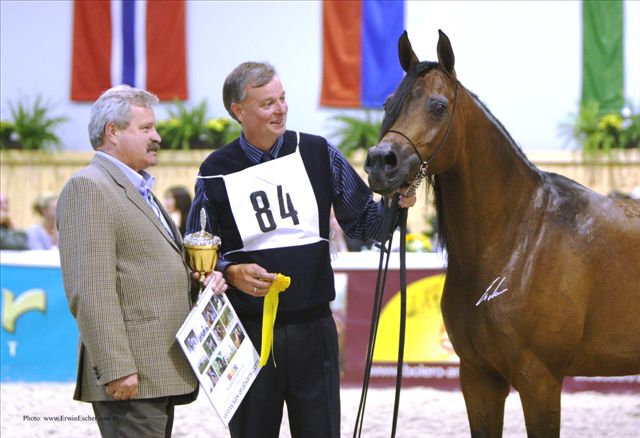
M.L.: After the information about another journey of Pianissima a real thunderstorm in message boards began – the users claimed it was another eyewash, that the point was to get the most embryos possible, that it was no good for the horse, and that the mare deserved an ordinary, horse’s life.
M.T.: I wonder where all those comments came from. I have been to many American studs and it is impossible to find anywhere else this kind of individual care that is provided to horses. It is an extraordinary mare, it is impossible to define her value in prices that were given in this business. Whatever the people say, this horse will be treated the very special way. I don’t know what does ‘an ordinary horse’s life’ stand for. Pianissima deserves the highest quality care. She deserves that her first foal which will be born the natural way, shall
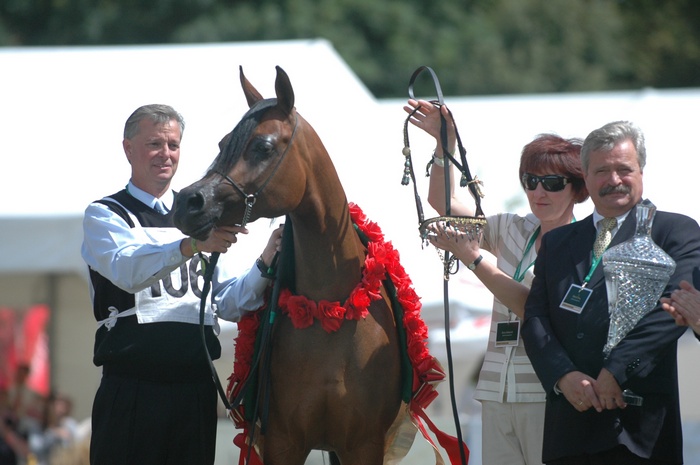
have the safest birth. She will have her first foal at the age of 6. In case medical care would be necessary – the best is in the United States. And it is immediate! Piaff, which got colic while in the US, was operated on in half an hour and he is currently in our chief stable. And Pianissima’s mother, Pianosa, suffered from cecal volvulus a couple of hours after giving birth and despite the doctors were desperately trying to save her life, she is no longer among us. That is the basic reason why Pianissima won’t give birth in Poland. But of course, she will come back.
M.L.: Let’s have one thing straight: will embryos be taken from Pianissima during her stay in America? After she gives birth to a foal by Ganges?
M.T.: We will see. She will not be an embryo factory, I can promise. But I don’t know if we won’t flush embryos, as this practice is in common use and it is allowed in many countries. International stud books don’t forbid it. However, in order to maintain the discussion at message boards, I won’t say anything more… The best way of discussing is to discuss about somebody else’s horse – everybody knows which horse should be covered and how, where the horse should be shown, and where shouldn’t. Every horse, but not its own one.
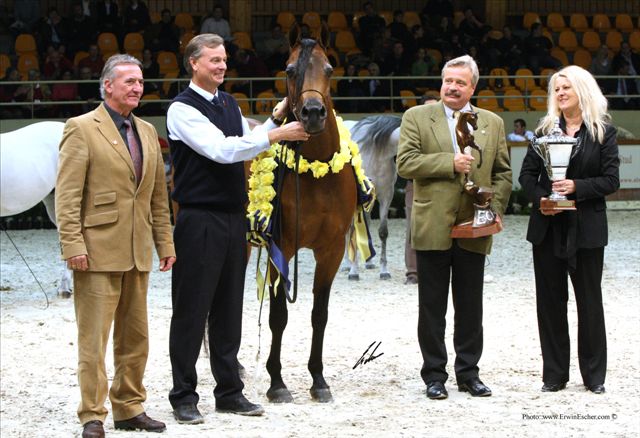
M.L.: There were many speculations about her first natural mating. She was said to be bred to QR Marc, other stallions were also named, but never Ganges, which you have chosen. Why Ganges?
M.T.: The plan was different indeed, however, the time passed, foals by Ganges were born and it turned out that their quality gave us hope that Ganges will match with Pianissima. Besides, we gave her chance at last to be covered the natural way. I have greater hope with foal by Ganges than by any other world wide known stallion.
M.L: If the plan was different – does it mean there were some difficulties in breeding?
M.T.: No. Just while we were planning Pianissima’s show season we didn’t want to cover her to early. We gave up other plans, when we saw that Ganges had adjusted to Janów’s mares and he stands a good chance of successfully combining with them. But we can never foresee the effect… That’s why it’s so fascinating! If it was easy to draw everything on the computer, it wouldn’t be worth to do it.
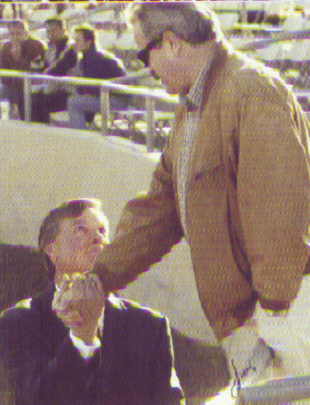
M.L.: There is a picture from Scottsdale, where you are looking with an absolute confidence at Greg Gallun who is shaking your hand. This picture shows that you are absolutely convinced that what you have brought to Scottsdale is without any doubt exceptional.
M.T.: In that very moment my confidence got strongly disturbed. In fact, I was convinced that Pianissima was going to win the whole championship; there wasn’t any rival! However, two of three judges had a different opinion… Well, the mare that finally won didn’t show herself in the best light at any other show. This show astonished me completely. The mare that won was the last one that I expected to win! Was it due to American judges’ different taste? I don’t think so, because later Pianissima was hailed with a standing ovation as the new champion of the United States while she was three years old and the three-year-old fillies are said to have no chances. The last champion at the last show organized in Lexington… The people travelled a thousand miles to see her, to stand near her for five minutes and to stroke her. It turned out there wasn’t a huge taste difference.
M.L.: How do you put up with shows? Do you keep professional’s calm or are you sometimes blue in the face?
M.T.: It is some kind of game, it is impossible to be confident all the time… And emotions are the bigger the bigger are chances of a horse to win. Beside of presenting my own horses I travelled a lot as a vet of our team and I know how strange cases can happen. I will never forget how Emanacja went lame at European championship. She left the stable in perfect condition and she entered the ring limping! While she was entering a stone stuck in her calf bone. When she left the ring we managed to get rid of it, but it was all over… However, it is better to have this kind of emotions instead of none.
M.L.: Pianissima set such a high standard that it is basically impossible to beat her: she won the Triple Crown twice! Which sights does a breeder set who already achieved this kind of success, so difficult to beat?

M.T.: But there are many shows in the world where she was not present yet! For the moment the time has come to breed, we will see how many foals she will have, but maybe we will remind her to the others… Hunting new Triple Crowns doesn’t make sense of course, however, if there is any occasion of presenting her somewhere, then, why not? It wasn’t the World Championships though, which gave me the biggest pleasure, but a show at Al Khalediah. It happened something incredible there: I realized the Arabian orchestra had been playing the Polish national anthem and it had been in Nejd – the place where Arabian horses come from! A horse from Poland wins a championship there; it was an incredible loop of history… this puts the Polish breed in the history of the breed. And a Polish flag with Polish anthem between Mecca and Riyadh in these horses’ native country – it has been an enormous joy.
M.L.: But what happens next? Will you wait for another foal such prominent as Pianissima?

M.T.: Our whole job is to search and to breed as many prominent horses as possible. But we have to realize that prominent horses are born quite rarely. Taking the Janów history into consideration, the most similar horse to Pianissima was Pilarka – her great-grandmother. She was the last one that was causing that kind of emotion and reaction. The shows were more modest, there was no setting like now, but I remember a standing ovation in Ostenda. The mare wasn’t doing anything at all, just standing and watching the people, and the audience was absolutely crazy, screaming and applauding. The boy held the end of rope and the horse caused these emotions itself. She received loads of twenties from seven judges; it was an unforgettable experience. But a couple of generations had to pass before Pianissima was born. Pilarka turned out to be such an effective broodmare that now we have Pianissima through Pinia and Pilar through Pipi. She established a mighty family in Janów. There is also Pinga, Pianissima’s cousin, which doesn’t stand down at all. We have to think hard and to beat our breasts whether we gave her enough chance to show up. Now they both stand side by side in one stable – but in the United States.
M.L.: Pilarka, as we know, has been sold. Will Pianissima be sold someday as well?
M.T.: The stud is a state property, so I can’t decide about that. Sometimes it is necessary to resign from one horse in order to keep the stud existing. But I remember how director Krzyształowicz felt when he sold Pilarka…. I’m sure it isn’t pleasant. We tried to buy her back, to provide her a safe home for old age. We didn’t manage it, but fortunately she found a shelter in Halsdon Arabians.
M.L.: However, before it happened, she suffered quite a lot… It turned out that when she left Poland a real life of misery started.
M.T.: Fortunately she wasn’t in the group of horses that were starving. But the uncertainty was terrible! By now the situation does not force us to sell her. Pianissima will come back to Poland for sure – however, we are still planning the route of this return journey.
M.L.: We have mentioned stallions… Availability of frozen semen is the sign of modern times. Janów also benefits from stallions from Middle East or America. Which one promises to do well on mares from Janów?
M.T.: We didn’t use many of them and there is still too little offspring in order to pass judgment. Of course, until now the best one was Gazal Al Shaqab, an American product, because, although he was born in Qatar, his mother went there pregnant from the USA. However, it would be difficult to call him an “outside” stallion as the situation was quite similar to the one with Palas; the result of blending an Egyptian stallion with a Polish mare. The thing that really charmed me about Gazal was his beautiful mother Kajora: a strong mare, with an enormous eye, long neck and great achievements in the United States – she became a champion of this country. From all stallions that have been used recently we can say a little bit more only about Enzo. There was also Sanadik El Shaklan, but he gave very little offspring, from three foals born in Michałów El Dorada stood out, and the only one born in Janów is Andaluzja, one of our best mares. In this matter his effectiveness can be considered exceptional. In Enzo’s case, we have yearling foals, so it is too early to announce a verdict, however they are horses in modern type. This was the idea and these were the mares he received: the mares that need more air, it means, lengthening their legs, shortening their topline – and he did it quite efficiently. There are many yearlings that are brilliant and then disappear at the age of 2 or 3. This happens even to those sires that are the most fashionable right now. Encouraged by foals by Enzo, we used him last year as well though in minor degree, as well as his son Eden C which seems more adequate than his father. We will find out when foals are born. We also used QR Marc; it is a very interesting horse with an excellent type, not of “outside” blood line as he is by Marwan – we will see what kind of horses will be born. We also used in a small degree semen coming from a stallion called Hlayyil Ramadan, which has always impressed me with his beautiful eye. I enjoyed the most judging him in English system – I could just stand there and watch him. And the views were incredible – this kind of horse with so beautifully deep set eyes, in a dark setting I haven’t seen before. And it is a very strong horse, massive, from Jordanian dam line that is practically unknown in our country. And, finally, we have only two foals by Al Adeed Al Shaqab; one is curing a heavy injury which seemed hopeless, but everything points out that the case is heading to a happy end.
M.L.: You mean the so called “Stefan”, the last foal out of Pianosa…
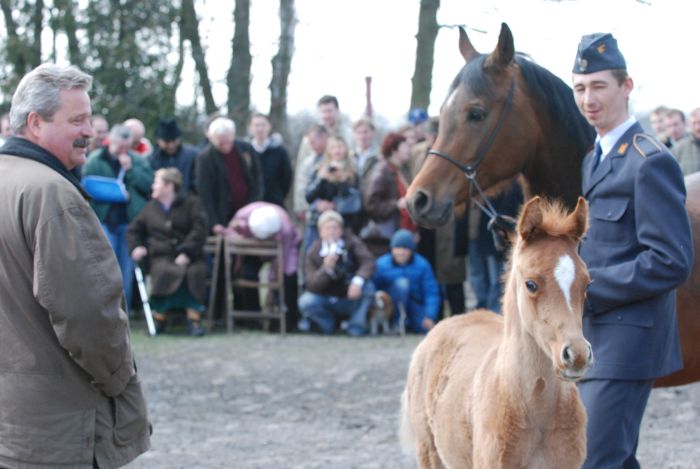
M.T.: Yes, “Stefan” who is well known at the whole Służewiec race track. He’s got his own wardrobe with a mirror, his toys and the stable is his kingdom – he lets some people in, and the others are not invited. He is famous, although he can’t speak, but he nearly makes it… Soon he will come back to Janów and the whole track is discussing whether we will be able to provide him the proper care as he deserves a special attention. And the filly out of Pilar is still developing, it is difficult to say something about her. The most foals by foreign stallions will be born this year and we will be able to compare. Foals sometimes loose with age their type, they become more rude, but those by Enzo, despite they were growing more rapidly they develop in a quite promising way. Eden C is a contradiction of what Polish breeder likes – a bald chestnut, white legs… Anyway he has something special that attracts an eye view and gives an impulse to try. Maybe I’m wrong but I think there is something special about this horse.
M.L.: Some voices are heard, claiming that using stallions from the other side of the Ocean, in an American type, can cause an ‘Arabian globalization’: the pure Polish type will lose its character and the customers won’t come to buy horses by stallions available also in their neighborhood.
M.T.: I have already said – somebody else’s horses are the easiest to breed. Everybody but not Poles knows what a pure Polish is, and what is not. It has always been that way. I remember how badly director Krzyształowicz was criticized for using Palas. He was told: It won’t be pure Polish any more! And now, does anybody remember that Palas and Pilarka were not pure Polish? What shall be the pure Polish? What is Polish fits the best way to Polish breeding philosophy. We would have found ourselves in a desperate situation if we hadn’t looked for fresh blood. A long time ago the best material was being conquered during war period. It has been always very strange to me – who takes his best horses for a war?! Then I understood that life was the most important value, so the thing that could save it, had been taken. That’s why the invaders were riding the best animals they had. This was the source of fresh blood. And last, historical expeditions, when one hundred people were travelling during three years in order to bring five stallions and three mares, after watching a thousand horses? Horses of highest quality have always been searched and that is the basis of Polish breed. We cannot wander around Arabia and search for horses, we are searching another way. Everyone who travels and investigates what is going on in the world, does it in order to find new stallions and to use fresh blood from time to time. There are no fixed recipes, everything depends from the breeder’s nose. We currently have greater possibilities than our predecessors a dozen or several dozen years ago. They could bring fresh blood only with backdoors, through other socialist countries – that’s how Aswan’s blood came. However it doesn’t mean the current situation got much better, because we have a few prominent stallions and if you asked me now which famous stallion I would use, I would think for an hour and you would leave without any kind of information. I don’t have my favorite, a horse that I would be in love with. For example, Marwan is very fashionable, although I would prefer Gazal. He is nearer my imagination about how an Arabian should look like. If we watch closer every prominent horse, we can notice not only its advantages, but also its disadvantages. And we require a lot from a stallion. There are some disadvantages that – although well hidden – disqualify a horse totally.
M.L.: How would you define the Polish breeding philosophy you have just mentioned?
M.T.: First of all, Poles have been always breeding performance horses. The aim was to breed a horse fitting to the saddle. But a handsome one as well. That’s why the biggest attention has been paid to the good looks, to the Arabian beauty. It is clear for a rider that it’s better to ride a horse with a pretty, swan alike, beautifully embedded neck than a horse which
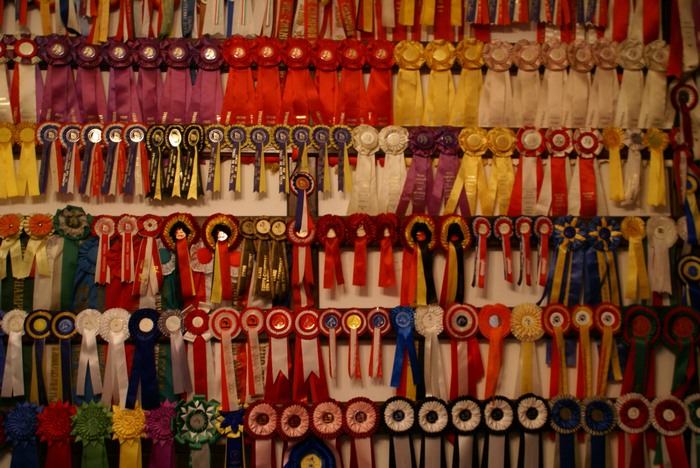
has a short, low embedded one. It is better to lead this kind of horse. And if it has beauty, a part of it comes to the rider. A horse with an excellent movement, with an excellent action, which is highly appreciated in field rides, with an excellent topline, hardy – this is an ideal one. And we have that kind of horse, although we cannot always show how it is like. However, this is the reason why Polish horses are so valued. We compare our horses – in show rings often with success – with American breed but it is like comparing David with Goliath. We have about thousand mares in Poland, but in the United States there are more than twenty thousand! It is an enormous scale! And not a long time ago we used to have just two hundred mares. The interest of other countries which have a better developed endurance sport, is symptomatic. We sell more and more horses to those countries. It seems that the level of training and preparing horses to endurance will be higher in Poland. Piruet is said to give excellent endurance horses. But the point is that Piruet was available there and he could demonstrate himself. Every different Polish stallion would maybe give even better offspring with endurance capacities. If for example Balon went to France the results would be excellent. After every single triumph at the show ring lots of voices are heard that Arabians are like poodle dogs led on a rope. In fact they are really doing well in other disciplines. For example, at our stud – in Janów the youth is riding breeding sires to a training in the hall. Ten breeding sires are being led by children. It means the selection went the right direction because we didn’t bred some kind of crazy monsters that are just dreaming about killing anyone who rides their back, but human-friendly horses, easily handled, and easy to ride. We have a racing stable – during just two weeks twenty three-year-old horses were broken in for riding and now they gallop with horsemen on their back. Not only experienced jockeys but also amateurs.
M.L.: It isn’t always easy to come to terms though… Pianissima doesn’t go under saddle.
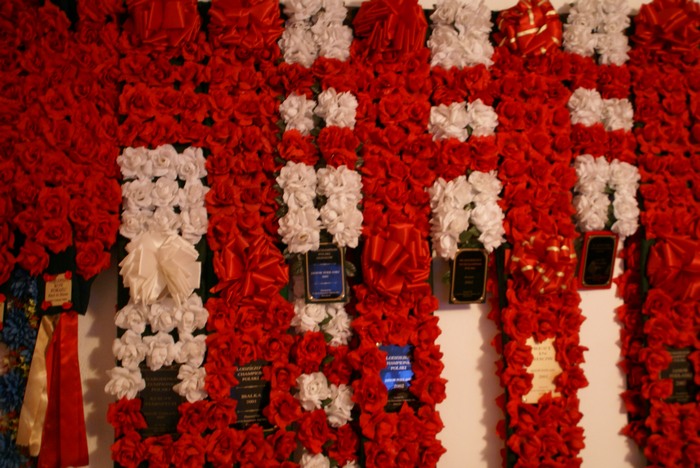
M.T.: But horses like Pianissima or Sambor are not born every single day. And not every day Niniwa, which jumps excellent, is born. I remember when I started in this sport, there was once a competition between two Arabians: one was called Nalot and the other Noter. Nalot was a member of the national team. He wasn’t seen from behind the oxer and suddenly it showed up over the obstacle. It was a very talented pure Arabian blood jumper – by Banio out of Naganka. The fact that those individuals appear is the best certificate for the breeder. And, from time to time, horses like Batyskaf, which was a Derby winner and Polish champion, Pamir, which was a Derby winner and Polish champion, or Arra, which was a Derby winner, Oaks winner and European champion. This is a target of a breeder. I would love Pianissima to win Derby, but… it’s too late already, she hasn’t been broken in for riding, her time has passed… But seriously, she also worked a lot. Not under the saddle – Pinga went under the saddle, and Piassima ran by. They were both well prepared to the national championship – Pinga and Drabant got the biggest score for movement.
M.L.: What was your way to breed Pianissima? And the first Arabian that you remember?
M.T.: It was Pepi. When I was offered a job in Janów, I rushed to the track to see how do these Arabians look like. And Pepi was starting. I wasn’t sure whether I liked him or not, however, the argument that convinced me to start a job in Janów was the fact that we have Anglo-Arabians here and that I could be riding so much as I wished. The director Krzyształowicz promised me that, although he forgot to mention that they had two thousand cattle as well. So he was right – I could ride so much as I wished, it meant I couldn’t at all because I was too tired when the day ended. So I came to Janów because of Anglo-Arabians. And the first horse that proved to me that there is something extraordinary about Arabians, was Fanza. We were visiting stables with the director Krzyształowicz, I was quite scared off by the whole situation. Almost all horses were at the pasture, so the stables were practically empty; it was at the end of September. We arrived at the Fanza’s box, the horse was completely blind. Despite of this fact, she managed to breed many foals and she was so trusty that even children were riding at her back on the paddock. This blind mare permitted the children to control her! Today, according to the current criteria, she wouldn’t be a wonder of nature but I liked her very much that time. She emanated something exceptional… Then, of course, my patients became more and more closer to me. And this year it will be 31 years since I started working in Janów Podlaski.
M.L.: What benefits can give Arabian horses breeding? How do you experience lapse of time thanks to Arabians?
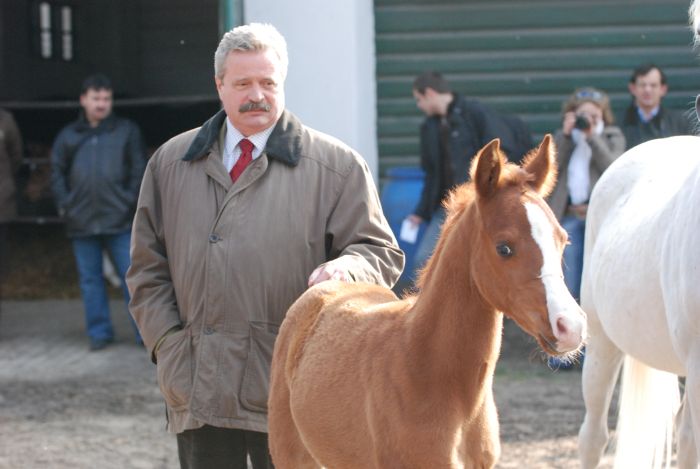
M.T.: You always have to wait for something. And always there is something to do, you always have to plan one step to the front. The idea that you come up with today, might be realized in a few years. The breeder isn’t always able to eyewitness what he had planned. Sometimes this first step should serve to make the next one. Planning the livestock, choosing stallions, planning horses for sale – you think about it all the time and even when the plan is ready, before you put your thoughts on the paper there are so many doubts… And horses for sale is a real tragedy, is a struggle against yourself as sometimes getting rid of a horse is a great pity. However, who would be coming to our auctions if we were selling defective horses? There must be something, some kind of magnet that would attract the people. The auction in Janów survived as perhaps the only one in the world because people still have something to see, and we still haven’t sold everything.
M.L.: There is an opinion that this year’s auction in Janów Podlaski, the jubilee one, so even more important than the ordinary ones, could be the crisis one.
M.T.: Logically thinking, yes. The only thing we could cling to is the experience which teaches us that Janów is a magical place. Please, explain to me, who could’ve convinced people to visit Janów during the Martial Law or a couple of months after Chernobyl disaster? A big dose of madness was necessary to come to this region those times. But anyhow, the auction was held. It means Janów’s star is still shining.
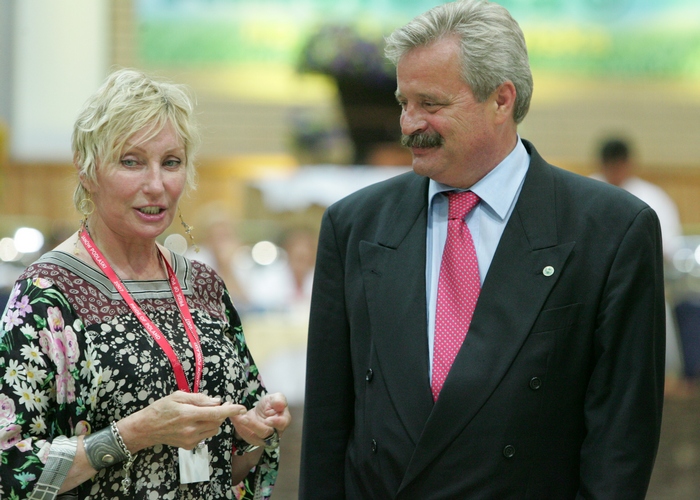
M.L.: Will some kind of special offer be prepared?
M.T.: Every offer contains something special, I don’t remember any auction in which there wouldn’t be anything special. Currently everyone is trying to settle the plan in their mind, and unfortunately, soon the selling list will have to be transferred to a piece of paper. The basic line of auction has to be settled: there must be stars that would draw the rest.
M.L.: Do you witness some kind of changes in mentality of people that come to buy Arabian horses?
M.T.: The places of the world where buyers come from are changing. Before everything was clear in advance, that the best horses will go to the United States, these from the second wave – to Sweden, then Germany… Now it has changed, Europe started buying higher class horses, as well as the Middle East. Some surprises happen – somebody, who disturbs the status quo. So it’s difficult to plan something. We cannot foresee where these horses will go. It is easier to follow them (for example, at the shows), when they stay in Europe. But when Siklawa is successful as a Qatar mare, it is also an advantage for us.
M.L.: Is Middle East an insatiable market? Their own horses are better and better.
M.T.: Europe didn’t stuck in one place, neither did Poland. The type of horse is still changing, the breed is evolving, and until we can keep the high level, Poland is safe, we will be able to sell horses. Look closer what is the advantage of Middle East – a lot of horses has been bought, however, in that place some real pearls can be born, just like anywhere else.
M.L.: There is no sales without marketing. ‘Marketing’ careers of some Arabian horses are fact. There are some horses that have to win because it has been written in the marketing strategy. Otherwise hundreds of breedings won’t be sold.
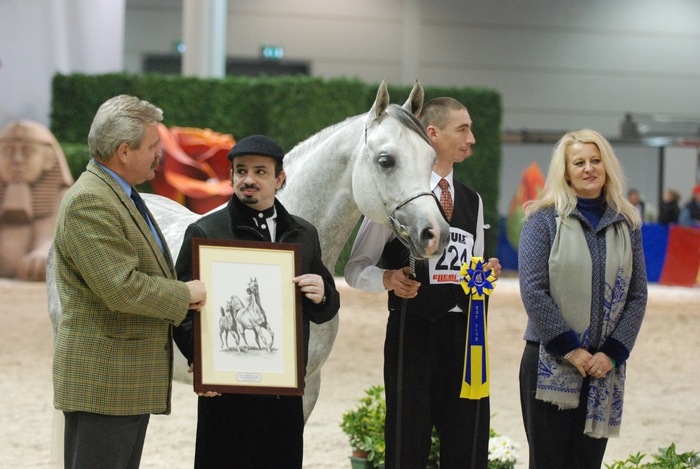
M.T.: I have a dilemma here, as I play a double part. I try to use the marketing, but on the other hand, as a judge, I cannot be subject of it. I would be very disappointed if someone thought that something else, not the quality of evaluated horse, was what guided me. But marketing is not only advertising, it is also preparing and showing the horse. It is very important. These studs that are most successful take the best people that prepare the horse and provide it a condition training. How did Marwan look like in Paris and Aachen? He was a real sculpture! A real athlete, bodybuilder where every single muscle can be seen. There was no single pound of fat, everything was trained. This horse is not allowed to loose! Not with a fatty dragged out of a stable which can move properly though… like Poganin. He made a very good impression, but if we compare Poganin to Marwan, the first one is not prepared properly. I’m sure he will show his abilities in the future, although it is not easy to prepare him for this. Besides, we don’t have sufficient abilities and we can’t hide it. And determination… The fact that someone is a better or worse trainer is not a result of opinions. Let’s look at the best ones. Even if they take a horse five minutes before the show they communicate with him. Michael Byatt, for example, doesn’t show every horse the same way. One horse is being shown on a three-meter rope, and the other one is kept shortly. You must know that. And in order to know that, you should have a special gift. And there are not many people which have it. Due to all these things there are horses that have bigger chances. And besides, we don’t have an intensive marketing at all. I just think that taking part in shows is the best way of advertising. Michałów started it a long time ago and we are also going to show up with bigger amount of horses. We want to have a more developed show stable.
M.L.: After important shows some complaints about the judges’ work can be heard – that they are prejudiced, that those horses that were supposed to win, won indeed, that the shows are predictable… Do the judges succumb under pressure, or force their private interests, acting like agents?
M.T.: After each show there is one winner and many others that have lost. Some people search the fault in themselves, others are looking for some external factors. I can say without any doubt that I have never experienced any kind of suggestion from anyone that could’ve had influence on my judging decision. But sometimes even a winning horse can be in worse condition and loose. For example, last year’s championship in Paris. I know all those judges and their taste, I could’ve foreseen how they would evaluate. The most important factor was the taste. A very charismatic horse, but with conformational flaws will never win the horse that has a correct topline, good legs, is equally typey, and with good movement. In the direct comparison there is a temptation to reward the more charismatic one but the correct one will get more points. From several dozens of years there is a discussion whether the point or comparison system is better: in a ‘Jeździec i Hodowca’ (‘Rider and Breeder’) magazine from 1937 I read an article about which of those two systems is better and more fair. The answer is there is no such system. I’m convinced that judges don’t want to be ashamed of their job. Many times I was leaving the ring very disappointed because the horse that won, in my opinion didn’t deserve it. Even at the biggest shows similar situations took place. However, the main reason that there are so many judges is to get an average opinion.
M.L.: Why Polish judges are not present at the most important events – in Aachen, Moorsele, Paris?
M.T.: Because of interest conflict. I was judging in a couple of shows, where I couldn’t judge any championship. From the organizer’s point of view, it doesn’t make any sense.
M.L.: Last year quite big group of Poles finished the judging course. Did you find out that the time had come to let some new, fresh blood as candidates for judges?
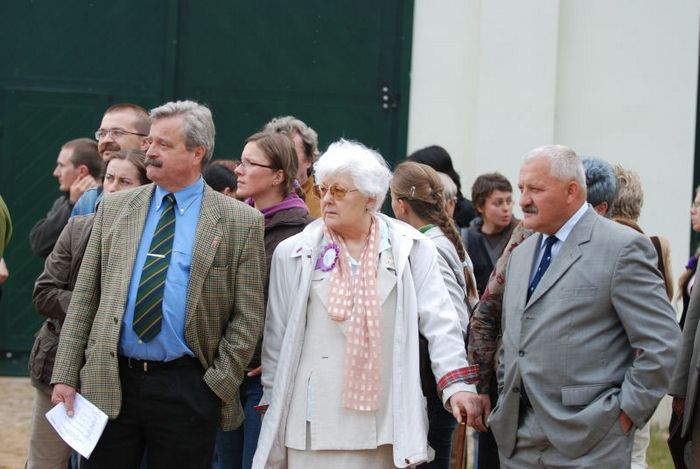
M.T.: I don’t think there was some kind of opposition against new people in this environment. But… there was lack of people that would be willing to do the course! Judging courses were made before, people from Italy, Denmark, Sweden were coming, but there weren’t any candidates from Poland. There was no limit issued by superior authority. The limit was the necessary language or horse’s anatomy knowledge. But we decided to go further and to invite Poles to our course. I think that in this group there will be a couple of people that will become judges in the future. We also want it to became some kind of education. We do care about knowledge of Polish judges, we want them to be superior. And what did the course show? It definitely demonstrated big differences in Arabian horses’ knowledge… However, the people who passed the course will have a chance of participating in ECAHO courses. And ECAHO decided to organize their courses in Janów – because we have good conditions, we have adequate people, we have horses. In the main degree the point is to unify requirements. The first course will be held at the beginning of April. So the courses, instead of being organized in a different place each time, will be organized regularly in Janów.
M.L.: What was the most strange or the most difficult journey of yours related with judging?
M.T.: To Australia! It was a marvelous journey… I was a vet in practice and I did something I wouldn’t recommend anybody to repeat: I went to Australia for three days. The fact is it took me six or seven days. After thirty-hour flight I arrived to Brisbane in the evening. I couldn’t sleep because it was a daytime in Poland, and at 7 AM I was at the ring as the only judge and I started judging by comparison system. The Arabian horses, half-blood Arabian, quarter-blood Arabian, Anglo-Arabian, related to Arabian… Many horses were passing by in front of me, and I was afraid whether my concentration allows me to last till the end of the day which ended at 9 PM. There were championships in a similar style next day and then I came home. And in next three months I didn’t know whether it was day or night and if it was me walking upside down or the others… It was terrible, everything got messed up.

M.L.: Your passion was inherited by your son, it’s something that doesn’t happen very often. Are you glad that your son is following your steps?
M.T.: He was supposed to choose his future and I was the last person, that would try to persuade him to choose veterinary. But it’s impossible to fight the genetics… I have two sons, both are very keen on horses, but one of them more. In my opinion, the most important thing is he had chosen the profession that fascinates him. However I have never thought of building some kind of dynasty influences in Janów. It is a state company. I found myself here accidently, and then I started administrating this place. I’m sure my son will be successful in his job but not in Janów. If it had been a private company, I would’ve been glad that I had somebody that would inherit it, but in this situation, Jasiek wouldn’t feel comfortable.
M.L.: Do you talk a lot about horses during your family meetings?
M.T.: As long as my wife tolerates it. In one moment the margin of tolerance disappears and we have to change our topic of conversation.
M.L.: Is 190 years of tradition some kind of ballast for you?
M.T.: It is on my back all the time… Show me a person who would like to become the last director of a 200-year-old company! It is a huge responsibility and I have to cope.
M.L.: Is there something you would like to pass to private breeders? What should they remember? What could you advise them?
M.T.: I wish there was a bigger understanding of what state studs do. I wish it wasn’t treated like a competition or fight and that people finally understood that we were undertaking some kind of mission and we wanted private breeding to be the best. I don’t imagine anyone in our stud refusing a private breeder council or help. What we say, we say with deepest concern. Maybe it isn’t always what the breeders want to hear. All kind of advice comes from our best knowledge and our good will. However, Arabian horses are our national good, that we should care about in state studs. And private breeders should appreciate what they do, deepen their knowledge, participate in events and don’t break down by failures. If it is a hobby and joy the results will come. Breeding shouldn’t be treated in business categories, because profits will come when someone likes what he does. If something is done only for money a failure is what will happen.


